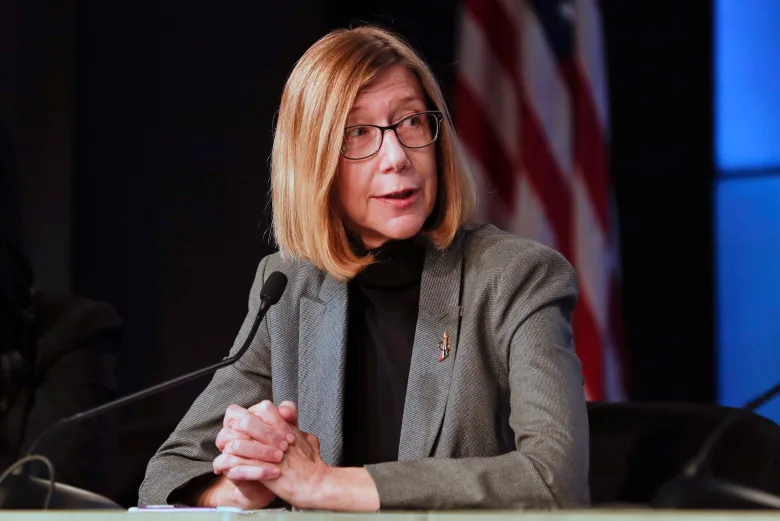After more than four-and-a-half decades of co-operation between the United States and Russia in space, tensions over Ukraine threaten to compromise the future of the International Space Station (ISS).
On Thursday, Russia’s space agency Roscosmos tweeted that they will no longer co-operate with Germany on joint experiments on the Russian section of the station.
Dmitry Rogozin, the head of Roscosmos who is known for his brash statements, has warned on Twitter that if Russia pulls out, the station could fall uncontrollably out of orbit and come down over populated areas such as China or India.
It’s not an entirely empty threat. Even though the space station orbits 400 kilometres above Earth, it still runs into thin traces of the atmosphere that constantly slow it down by small amounts.
To keep it aloft, Russian Soyuz and Progress supply ships visiting the station have used their thrusters to give it regular boosts to maintain its orbit. Without those boosts, its orbit could conceivably degrade to the point where it would be at risk of falling out of the sky, though that would take years.
Kathy Lueders, head of NASA’s human spaceflight program, told reporters on Monday that the station was operating “nominally” and that they were “not getting any indications at a working level that our counterparts are not committed,” according to The Guardian.
Other options for boosting ISS
There may be other options. Elon Musk hinted that his company, SpaceX, could take on the task of boosting the station. The Cygnus supply ship, made by the U.S.’s Orbital Sciences Corporation, has flown to the station since 2014, and it has tested its powerful booster to see if it can provide the critical boost.
But many in the space business hope that these alternatives won’t be necessary and that the Russians will continue to be part of the program until the station is scheduled to be intentionally decommissioned and brought down around 2030.
“As a team, we are looking at where we may have operational flexibilities, but … it would be a sad day for international operations if we can’t continue to peacefully operate in space,” Lueders said.

This isn’t the first time in recent years that international tensions have spilled out into low orbit.
When Russia annexed Crimea in 2014 and sanctions were imposed by the U.S., there was concern that the friendly relations between the two superpowers would end, and that Russia could prevent the U.S. from even reaching the station. At that time space shuttles had been retired, so Americans were totally dependent on Russian Soyuz spacecraft to reach the orbiting laboratory.
At the time, Rogozin quipped that Americans would need a trampoline to get there.
But despite political tensions, the ISS program continued without interruption.
A ‘mini United Nations’ in space
In 1975, American astronaut Tom Stafford shook hands with Russian Cosmonaut Alexei Leonov through a module, connecting their two space capsules in the symbolic Apollo-Soyuz Project. It marked the end of the Cold War space race to the moon and the beginning of a more co-operative approach to space exploration.
Two decades later Russians and Americans would work together again as both space agencies faced financial difficulties from U.S. budget cuts on one side and the collapse of the Soviet Union on the other.

The Soviets had flown their Mir space station in 1986. The U.S. had planned through the 1980s to build a station called Freedom, but it faced challenges because of its tremendous costs.
As a symbol of international co-operation with Russia after the end of the Soviet era, a new agreement was signed in 1993 for an international partnership that would share technology and collaborate to build the ISS. Canada, Europe and Japan also joined in, with a total of 15 countries involved in the project.
Since the first module was launched in 1998, Russian rockets and American space shuttles added more pieces, ultimately building the huge complex up to its current configuration, as long as a football field with a mass of more than 400 tonnes.
It has been continuously occupied since 2000 and according to NASA, hosted almost 3,000 research investigations by researchers from more than 108 countries.
The ISS has become a mini-United Nations, hosting astronauts from 19 nations and demonstrating that when it comes to mega-projects in space, co-operation between countries makes a lot of sense.
No borders from orbit
International borders do not exist in space. Anyone looking down from orbit sees the Earth as a planet with no arbitrary lines drawn on it to distinguish who owns what. And co-operation has been a hallmark of the ISS program throughout its history.
Even though there is a Russian section, an American section, European and Japanese modules, all the crews work together. They have to as a matter of survival, as they thrive in the deadly environment of space.
Despite political tensions on the ground, the scientists, engineers, cosmonauts and astronauts have continued to co-perate, sharing information, ferrying each other up and down from orbit, demonstrating clearly how people from different political backgrounds and cultures can work together on a single project.

As space agencies look forward to returning to the moon and on to Mars, there are questions as to whether the U.S. will include Russia in its Artemis program to return to the moon, or whether the Russians will join with the Chinese in their space program.
Even amid the tragic circumstances playing out in Ukraine right now, it’s sad to think that the peaceful international alliance established with that handshake in 1975 could be broken.


